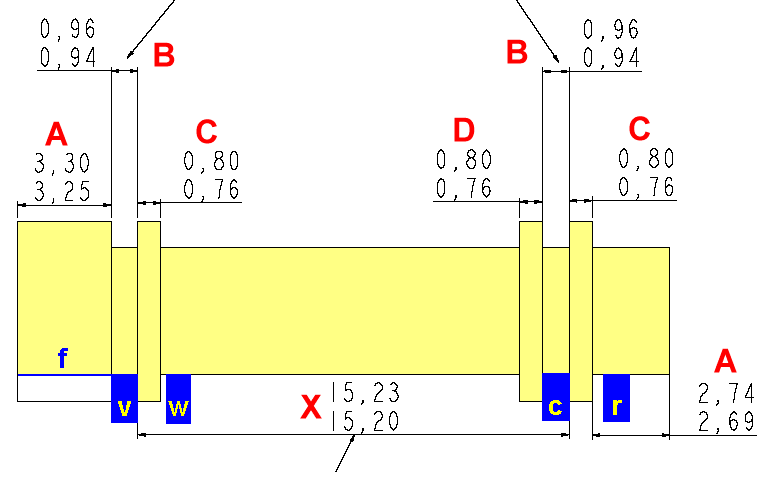Templot Club Archive 2007-2020
|
|||
| author | remove search highlighting | ||
|---|---|---|---|
|
posted: 26 Mar 2008 20:39 from: Martin Wynne
click the date to link to this post click member name to view archived images |
Dear all, I've just posted this on the 00-SF group, now that Brian Tulley has completed the sourcing of the excellent gauge tools for 00-SF. I thought it might be of interest here too. ------------------- Just a reminder that you also need a crossing flangeway gauge. This is a small piece of metal exactly 1.0mm or 40 thou thick. It is used to set the gap between the nose of the vee and the wing rails alongside it. Usually it is left in place while making the fixing -- gently hold the wing rails against the vee with the gauge acting as a spacer while applying solvent or solder. It's convenient to use feeler gauges for this, available from car accessory shops for setting spark plug gaps. If they don't have a 1.0mm or 40 thou gauge, the usual set of folding feeler gauges contains 25 thou and 15 thou feelers which can be combined to make 40 thou. They are very smooth and will stick together. They are stainless steel, so not affected by flux and no risk of being accidentally soldered. Alternatively, I believe 1.0mm crossing flangeway gauges are available from the EM Gauge Society. If that's not convenient, here is a trick you can use which is not affected by heat or solvent (unlike 40 thou plastikard, which may not be accurate anyway). Scale bullhead rail is 36 thou wide. Ordinary 80gsm office photocopier paper is 4 thou thick. So combining an oddment of rail with a bit of paper gives you an improvised crossing flangeway gauge for 00-SF (and EM). Rail+paper should just fit snugly in the gap without force. Take care not to accidentally solder the rail though. If the gap ends up a little wider than the gauge it's not the end of the world, but ideally you shouldn't be able to get rail and two thicknesses of paper in the gap -- beyond that running quality will be degraded. Remember that this gauge is used to set only the WING rails. It shouldn't be used for CHECK rails. Those are set using the excellent check gauge tools sourced by Brian, and getting the check gauge right is more critical than the crossing flangeway gap. Likewise the wing rails shouldn't be set with the check gauge tool. It's important to understand that the crossing flangeway gap and the check rail gap are two different things, even if they end up being the same size. Perhaps a brief summary of the construction procedure for a turnout would help. Most builders work this way: 1. Install the main road stock rail. 2. Install the crossing vee, gauging it from the stock rail using the track roller gauge or the 3-point gauge. (In the case of a roller gauge, a filed flat is useful on this where it fits over the nose of the vee.) 3. Install the turnout road stock rail, gauging it from the vee using the track roller gauge or the 3-point gauge. 4. Install the wing rails, gauging them from the vee using the 1.0mm or 40 thou crossing flangeway gauge. Usually the wing rails are bent continuous on the end of the closure rails, which are installed at the same time by gauging them from the stock rails. In the case of the 3-point gauge, the short side should be on the curved stock rail (inner rail of a curve). 5. Install the check rails, gauging them from the vee and from the closure rails using the check gauge tools. This is the most critical procedure in the whole assembly. Up to this point most errors can be fudged with a bit of filing, but great care should be taken when fitting check rails. Here's a diagram showing the check gauge tool being used to set a check rail: 00_sf_bf_check_tool.png  The blue rectangles represent the rails as follows: v = vee nose of crossing w = wing rail (clear of the tool) c = check rail being gauged from the vee r = running rail (stock rail) (clear of the tool) f = flat section filed or machined to clear the top of the vee. regards, Martin. |
||
|
posted: 26 Mar 2008 22:39 from: Brian Lewis
click the date to link to this post click member name to view archived images |
.......or, seeing as getting the relationship between the vee and the wing rail is really the only difficult part of constructing turnouts, you could just purchase ready made Common Crossings from C+L. Available 1:4 1:5 1:6 1:7 1:8 1:9 in HiNi Nickel Silver and in Steel. ++++++++ Note to Rodney Hills. B2B dimensions now feature on our web site. Thank you for bringing this omission to our attention. Regards Brian Lewis Carrs - C+L Finescale. http://www.finescale.org.uk |
||
| Please read this important note about copyright: Unless stated otherwise, all the files submitted to this web site are copyright and the property of the respective contributor. You are welcome to use them for your own personal non-commercial purposes, and in your messages on this web site. If you want to publish any of this material elsewhere or use it commercially, you must first obtain the owner's permission to do so. |